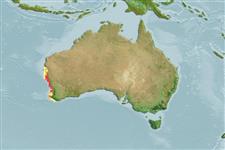Common names from other countries
Teleostei (teleosts) >
Syngnathiformes (Pipefishes and seahorses) >
Syngnathidae (Pipefishes and seahorses) > Syngnathinae
Etymology: Hippocampus: Greek, ippos = horse + Greek,kampe = curvature (Ref. 45335).
More on author: Castelnau.
Environment: milieu / climate zone / depth range / distribution range
Ecology
Marine; brackish; demersal; non-migratory; depth range 0 - 25 m (Ref. 30915). Tropical
Eastern Indian Ocean: southwest Australia.
Length at first maturity / Size / Weight / Age
Maturity: Lm 13.0 range ? - ? cm
Max length : 20.0 cm OT male/unsexed; (Ref. 30915)
Short description
Morphology | Morphometrics
Found on edge of rocky areas, muddy bottom and areas of high sediment load; jetty piles and moorings; often associated with sponges or sea squirts or attached to man-made objects; moves to deeper waters in winter. Ovoviviparous (Ref. 205). The male carries the eggs in a brood pouch which is found under the tail (Ref. 205). This species manifested evidence of genetically monogamous character in seahorses (Ref. 59213). Site fidelity is observed during breeding season (Ref. 59213). Length type refers to height (= TL - head length) (Ref. 30915). Minimum depth reported taken from Ref. 128812.
Gestation period 2-3 weeks, depending on water temperature. This species manifested evidence of genetically monogamous character in seahorses (Ref. 59213). Monogamous mating is observed as both obligate and genetic (Ref. 52884). Site fidelity is observed during breeding season (Ref. 59213). Male carries the eggs in a brood pouch (Ref. 205).
Lourie, S.A., R.A. Pollom and S.J. Foster, 2016. A global revision of the seahorses Hippocampus Rafinesque 1810 (Actinopterygii: Syngnathiformes): taxonomy and biogeography with recommendations for further research. Zootaxa 4146(1):1-66. (Ref. 115213)
IUCN Red List Status (Ref. 130435)
Threat to humans
Harmless
Human uses
More information
Age/SizeGrowthLength-weightLength-lengthLength-frequenciesMorphometricsMorphologyLarvaeLarval dynamicsRecruitmentAbundance
ReferencesAquacultureAquaculture profileStrainsGeneticsElectrophoresesHeritabilityDiseasesProcessingMass conversion
Tools
Special reports
Download XML
Internet sources
Estimates based on models
Preferred temperature (Ref.
115969): 18 - 23.7, mean 18.7 (based on 107 cells).
Phylogenetic diversity index (Ref.
82804): PD
50 = 0.5000 [Uniqueness, from 0.5 = low to 2.0 = high].
Bayesian length-weight: a=0.00447 (0.00177 - 0.01127), b=3.00 (2.78 - 3.22), in cm Total Length, based on LWR estimates for this (Sub)family-body shape (Ref.
93245).
Trophic level (Ref.
69278): 3.4 ±0.5 se; based on size and trophs of closest relatives
Resilience (Ref.
120179): Medium, minimum population doubling time 1.4 - 4.4 years (Fec = 200-700).
Fishing Vulnerability (Ref.
59153): Low vulnerability (10 of 100).
